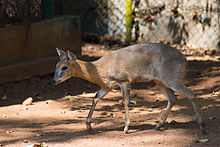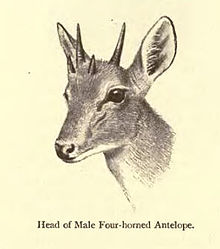Four-horned antelope
| Four-horned antelope | |
|---|---|

| |
| Bondla Wildlife Sanctuary, India | |
| Scientific classification | |
| Domain: | Eukaryota |
| Kingdom: | Animalia |
| Phylum: | Chordata |
| Class: | Mammalia |
| Order: | Artiodactyla |
| Family: | Bovidae |
| Subfamily: | Bovinae |
| Tribe: | Boselaphini |
| Genus: | Tetracerus Leach, 1825 |
| Species: | T. quadricornis
|
| Binomial name | |
| Tetracerus quadricornis (Blainville, 1816)
| |
| Subspecies | |
|
T. q. iodes (Hodgson, 1847) | |

| |
| Range map of the four-horned antelope | |
| Synonyms[2] | |
|
List
| |
The four-horned antelope (Tetracerus quadricornis), or chousingha, is a small
The four-horned antelope is diurnal (active mainly during the day). Though solitary by nature, four-horned antelopes may form loose groups of three to five –with one or more adults, sometimes accompanied by juveniles. This elusive antelope feeds on grasses, herbs, shrubs, foliage, flowers and fruits. It needs to drink water frequently; as such it stays in places near water sources. The breeding behaviour of the four-horned antelope has not been well studied. The age at which they reach sexual maturity and the season when mating occurs have not been understood well. Gestation lasts about eight months, following which one or two calves are born. They are kept concealed for the first few weeks of their birth. The young remain with the mother for about a year.
Four-horned antelopes tend to inhabit areas with significant grass cover or heavy
Etymology
The
Taxonomy and phylogeny
The four-horned antelope is the sole member of the
The authority for Tetracerus is variously indicated according to interpretations of the International Code of Zoological Nomenclature. The name was first published in an 1825 publication by English naturalist Thomas Hardwicke but cited the English zoologist William Elford Leach – probably by an editor – as the authority in a footnote at the end of the publication.[6] Philip Sclater and Oldfield Thomas listed Hardwicke as the genus authority by virtue of his being the author of the publication. However, Leach is now identified as the appropriate authority based on Article 50.1.1 of the Zoological Code.[2]
A 1992
- T. q. iodes (Hodgson, 1847): distributed north of the Ganges in Nepal[10]
- T. q. quadricornis (de Blainville, 1816): distributed in peninsular India
- T. q. subquadricornutus (Elliot, 1839) distributed in the Western Ghats and southern India[11]
Evolution

Though Boselaphini has no African representation today,
Fossils of
Evidence of early
Description
The four-horned antelope is one of the smallest Asian bovids. The number of its horns distinguishes it from most of the other bovids, that have two horns[24] The four-horned antelope stands 55–64 centimetres (22–25 in) at the shoulder and weighs 17–22 kilograms (37–49 lb); the head-and-body length is typically between 80 and 110 centimetres (31 and 43 in).[25] Sexual dimorphism is not very notable, though only males possess horns.[2]
Slender with thin legs and a short tail, the four-horned antelope has a yellowish brown to reddish coat. The underparts and the insides of the legs are white. Facial features include black markings on the muzzle and behind the ears. A black stripe marks the outer surface of each leg. Females have four teats far back on the abdomen.[2] The hair feels coarse, more like that of a deer than the glossy hair typical of antelopes.[26] The fetlocks are marked with white patches.[26]
One pair of horns is located between the ears, and the other on the forehead. The
The four-horned antelope differs greatly from the nilgai in colour, is much smaller and has an extra pair of horns. The nilgai is nearly nine times heavier and two times taller than the four-horned antelope. Two deer species, the
Ecology and behaviour
The four-horned antelope is
The antelope is shy and elusive. When alarmed, it stands motionless and may nervously leap away from the danger or even sprint. It often conceals itself in tall grasses to escape predators.
Diet

The four-horned antelope feeds on grasses, herbs, shrubs, foliage, flowers and fruits. A study in
Reproduction

Breeding behaviour of the four-horned antelope has not been well studied. The age at which sexual maturity is gained is doubted; two captive females had their first parturition at less than two years.[2] The breeding season in Panna National Park probably lasts from May to July,[30] and from June to August in Mudumalai National Park.[31] The male approaches the female in a relaxed gait, giving out low coughs. The two may kneel and push against each other with the necks intertwined. The male makes a few short mounting attempts; the female may be foraging all the while without any reaction.[30] Gestation lasts about eight months, followed by the birth of one or two calves. The newborn has a head-and-body length of 42 to 46 centimetres (17 to 18 in), and weighs 0.7 to 1.1 kg (1.5 to 2.4 lb). Juveniles are kept concealed for the first few weeks of birth. Births in Mudumalai National Park peak from February to April. Juveniles remain with their mothers for about a year.[2]
Distribution and habitat

The four-horned antelope is confined to the Indian subcontinent, occurring widely in disjunct and small populations. The range in India covers a vast expanse, from the foothills of the Himalayas in the north to the Deccan Plateau in the south. Most of the existing populations live in India, and lower numbers in adjoining Nepal.[1] The four-horned antelope inhabits open, dry,
It was earlier common throughout deciduous forests in India, but the population declined to an estimated at slightly above 10,000 mature individuals in 2001, with a decreasing trend.[35][1] Numbers in Gir National Park were estimated at 256 individuals in 1974; later estimates at waterholes in the same location put them a little above 1,000. Densities of above 0.7 individuals per km2 have been considered as being healthy.[37]
Threats and conservation
The four-horned antelope is threatened by the loss of its natural habitat due to agricultural expansion.[1] Moreover, the unusual four-horned skull and the horns have been a popular target for trophy hunters.[38]
The four-horned antelope is classified as
Major protected areas across India where four-horned antelopes occur include:[39]
- Gir National Park in Gujarat;
- Sariska Tiger Reserve in Rajasthan;
- Satpura National Parkin Madhya Pradesh;
- Tadoba Andhari Reserve in Maharashtra;
- Kumbhalgarh Wildlife Sanctuary, Ranthambore National Park, Rangayyanadurga Four–horned antelope Wildlife Sanctuary in Karnataka.
See also
References
- ^ . Retrieved 19 November 2021.
- ^ doi:10.1644/843.1.
- ^ a b c d Brown, Roland Wilbur (1956). The Composition of Scientific Words. Washington, D.C.: Smithsonian Institution Press.
- ^ OCLC 62265494.
- ISBN 978-0195621693.
- .
- ^ PMID 1570322.
- PMID 10380679.
- ^ a b Groves, C. (2003). "Taxonomy of ungulates of the Indian subcontinent". Journal of the Bombay Natural History Society. 100: 353–4.
- ^ Hodgson, B.H. (1847). "On the four-horned antelopes of India". Calcutta Journal of Natural History. 8: 87–94.
- ^ Elliot, Walter (1839). "A catalogue of the species of mammalia found in the Southern Mahratta Country; with their Synonymes in the Native Languages in use there". Madras Journal of Literature and Science. 10: 207–233.
- ISBN 978-0-226-07089-6.
- ^ Pilgrim, G.E. (1939). "The fossil Bovidae of India". Memoirs of the Geological Survey of India. New Series. 26: 1–356.
- S2CID 84545142.
- .
- ^ Solounias, N. (1990). "A new hypothesis uniting Boselaphus and Tetracerus with the Miocene Boselaphini (Mammalia, Bovidae) based on horn morphology". Annales Musei Goulandris. 8: 425–39.
- S2CID 8973690.
- .
- ^ Kostopoulus, D.S. (2005). "The Bovidae (Mammalia, Artiodactyla) from the late Miocene of Akkas¸dag˘i, Turkey". Geodiversitas. 27: 747–91.
- ^ Zhang, Z. (2005). "Late Miocene Boselaphini (Bovidae, Artiodactyla) from Fugu, Shaanxi Province, China". Vertebrata PalAsiatica. 43 (3): 208–18.
- ISBN 978-0-520-25440-4.
- .
- ^ Badam, G.L.; Behera, P.; Mishra, J. (2001). "Chalcolithic faunal economy at Khambeswarpally, middle Mahanadi Valley, Orissa: a bioarchaeological perspective". Current Science. 80 (7): 828–30.
- ISBN 978-1-284-03209-3.
- ^ Sharma, K.; Rahmani, A.R. (2004). "Four-horned antelope or chowsingha (Tetracerus quadricornis Blainville, 1816". ENVIS Bulletin (Wildlife and Protected Areas): Ungulates of India. 7.[permanent dead link]
- ^ ISBN 978-1-295-81380-3.
- ISBN 978-1-4027-5623-8.
- ^ Bentham, T. (1908). An illustrated catalogue of the Asiatic horns and antlers in the collection of the Indian museum. Kolkata, India: Indian Museum. pp. 46–7.
- ISBN 978-1-4008-8065-2.
- ^ a b c d e f g Sharma, K.; Rahmani, A.R.; Chundawat, R.S. (2009). "Natural history observations of the four-horned antelope Tetracerus quadricornis". Journal of the Bombay Natural History Society. 106 (1): 72–82.
- ^ .
- PMID 25714092.
- .
- S2CID 84489998.
- ^ .
- S2CID 83806831.
- ^ Rice, C.G. (1991). "The status of four-horned antelope Tetracerus quadricornis". Journal of the Bombay Natural History Society. 88 (1): 63–66.
- ISBN 978-0-8018-5789-8.
- ISBN 978-1-4349-8509-5.
External links
 Media related to Tetracerus quadricornis at Wikimedia Commons
Media related to Tetracerus quadricornis at Wikimedia Commons Data related to Tetracerus quadricornis at Wikispecies
Data related to Tetracerus quadricornis at Wikispecies



